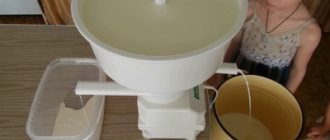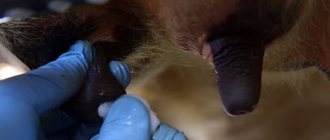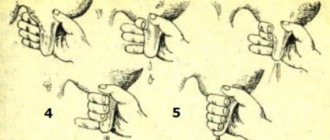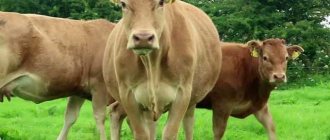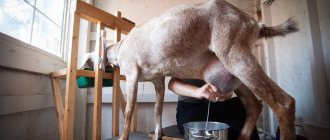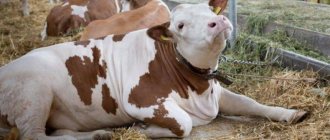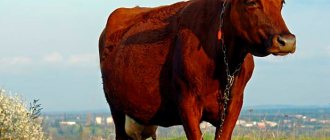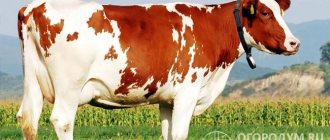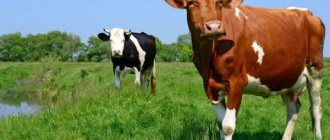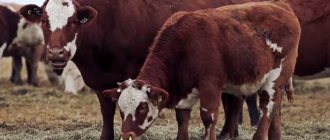ethnoscience
It is necessary to treat carefully and carefully to avoid complications.
To get the desired effect, you need to master a thoughtful approach to treatment. This is the only way you will be able to get the proper result, which is expressed in the health of the cow and her offspring. There are the following basic methods for ridding a cow of a painful and dangerous illness:
Phytotherapy. A special complex of herbal preparations, thought out to the smallest detail, has an extremely beneficial effect on the pet. The body and health are strengthened, the level of immunity increases. In certain cases, mastitis disappears without a trace. Natural homemade tinctures, solutions, ointments. Many plants and various fruits available to everyone are distinguished by their healing properties and characteristics.
In an active fight against unpleasant mastitis, you need to pay attention to beneficial algae and aromatic calendula. Useful and generous water compresses will help warm or cool a cow's sore udder. Therapy using ordinary clay, which is purchased at the pharmacy. Stimulation of biological points. The calf begins to suckle the udder differently. Gently introducing egg white into the nipple canals effectively helps get rid of mastitis.
Such simple techniques help farmers save their pets from painful diseases.
Calendula is an effective folk remedy for mastitis
What is postpartum paresis in cows?
The disease occurs within 3 days after calving and is associated with a lack of calcium in the body. High-yielding individuals usually suffer. The signs are:
- loss of appetite, chewing gum;
- anxiety;
- convulsions;
- tongue prolapse, drooling;
- low temperature, trembling.
Without the help of a veterinarian, 70% of animals die. The first aid for this disease is intravenous administration of glucose. Paresis can occur due to improper care of the uterus during pregnancy:
- excess concentrates in the diet;
- lack of walks in the fresh air during the stall period;
- cold during calving;
- dysfunction of the parathyroid gland;
- violation of the metabolic functions of the body.
To prevent postpartum paresis in a cow, it needs to be prepared. A week before calving, give the mother in labor sweet syrup - 300 g of sugar per liter of water, add vitamin D two days before calving and remove alfalfa and clover from the diet.
Prevention of mastitis in cows
Experienced farmers claim that the amount of finance for mastitis prevention is much lower than the amount of losses after the disease.
One of the common causes of the disease is considered to be a violation of the cow’s diet. Dairy cows during lactation need feed with a high content of vitamins and minerals. You can't suddenly change your diet. This leads to decreased immunity. The feed should contain both juicy and roughage in equal proportions.
It is important to properly take care of the hygiene of milking cows:
It is necessary to wash the udder before each milking to avoid transferring bacteria to the milk. You can wash the udder with a hose or soft towel
It is important to observe the temperature of the water; it should be warm. After cleansing, the udder is wiped with soft wipes. If there are wounds or cracks, they need to be treated with hydrogen peroxide, then iodine. Delicate skin should be lubricated with moisturizing creams or balms to prevent dryness.
Comprehensive prevention includes proper feeding, care and maintenance. The complex is as follows:
- carrying out daily walking of animals;
- regular preventive examinations;
- use of high-quality feed with the addition of enzymes and probiotics;
- the first few days after calving, the calf should be close to the cow;
- use of modern milking machines.
Hygiene must be maintained in the premises where animals are kept. Good cattle care and timely diagnosis will help detect the disease at an early stage and avoid major consequences.
Prevention
To prevent mastitis in a cow, it is necessary to follow simple preventive methods:
- the diet should contain enough probiotics, vitamins, enzymes that help improve immunity;
- the stall should be clean and dry. Moisture and drafts are not allowed in sleeping areas;
- It is important to wash your hands before expressing milk;
- it is recommended to give medications aimed at preventing mastitis;
- after birth, the calf is left with its mother to prevent the accumulation of colostrum;
- Make sure that there is no hard grass or thorny bushes on the pastures.
Recommendations for home treatment
To prevent the treatment outcome from being disastrous, solutions and ointments based on natural herbs are not used hot. The optimal temperature is 20-23 o C. It is not necessary to measure the temperature, just do a simple test. The farmer applies a small amount of the mixture to the outside of the brush: if the mixture does not burn and does not seem cold, the procedure can be carried out. A compress that is too hot creates a favorable environment for the active growth of bacteria.
Decoctions must be filtered, and ointments brought to a homogeneous state. Store them in a cool, dark place for 3 days. For compresses, use only sterile cloth or bandage.
Traditional medicine is great for relieving inflammation, but it will not cure advanced forms of mastitis. In this case, folk remedies are used as additional therapy during antibiotic treatment.
Recommendations for the care and maintenance of animals
After calving and before it, the room must be completely disinfected. Some farmers even rub the floor with iodine to disinfect the area for calving and further breeding. Starting a cow when it first begins to produce milk should be done with clean hands and in a warm place. If the pens are cool, the animals may catch a cold and develop udder inflammation. If milk milking machines are installed on the farm, they must be sterile, since any infection through the milk can enter the udder. If something happens, if a dirty milk machine becomes noticeable, it must first be washed and then put into production.
Along with antibiotics, you should ask your veterinarian to prescribe probiotics, since dysbiosis can begin after serious medications. Before each milking, as a preventive measure, you need to make it a rule to wash your hands with antibacterial soap. Before the milking process, the udder should be washed with warm water to remove dirt.
After calving, when starting, the calf is first allowed near the female so that the calf first drinks colostrum, and only after that milk. If such simple requirements are not followed, the cow will experience milk stagnation, which can provoke inflammation of the udder. The diet of lactating females should include foods and supplements to activate the immune system.
At the slightest suspicion of the occurrence of a disease, it is necessary to act, otherwise there is a risk of advanced mastitis in cows, as a result of which irreparable damage will be caused to the farm. At the same time, it is important not to forget that getting rid of the disease with folk remedies is not as effective as antibiotics prescribed by a veterinarian.
Is it possible to drink milk from sick animals?
The milk product during the development of inflammation is called “mastitis milk.” The use of this product is prohibited. From the very beginning of the disease, somatic cells develop in the milk. The increased number of cells makes milk harmful to human health.
Taking mastitis milk leads to the following consequences:
- diarrhea;
- nausea, vomiting;
- sore throat, other infections caused by streptococcus.
The presence of harmful microorganisms in milk can provoke a decrease in immune qualities and a deterioration in overall health.
Spoiled milk has a foreign, unpleasant odor. Sediments form at the bottom. When heated, milk curdles and the taste differs from the normal product. Homemade mastitis milk often contains impurities of pus or blood.
After the animal has recovered, several weeks must pass before the milk is suitable for consumption. During this time, the number of somatic cells is stabilized, as well as the chemical composition is normalized and the fat content is adjusted.
The cow was diagnosed with ketosis
Metabolic disorders in the body of cattle lead to excess ketones. High levels of acetone are detected in urine, blood and milk. These are symptoms of ketosis in a cow; treatment of the disease is carried out comprehensively.
In addition to the unpleasant taste and smell of milk, the consequences of the disease manifest themselves:
- a sick animal loses its appetite and loses weight;
- the uterus does not carry the baby to term, a miscarriage occurs;
- the calf is born dead;
- the cow quickly ages and must be slaughtered.
If a cow is sick, her milk is bitter, has an unpleasant smell of acetone and is unfit for food. The behavior of animals is unstable, from overexcitation to a depressed state.
Treatment is carried out with medication; acidic supplements and concentrates are removed from the diet. Intravenous injections are carried out, and formulations are administered in a mixture of antibiotics and salts according to Sharabnin.
Preventive measures against ketosis in the diet of animals in the summer include:
- beets;
- molasses;
- potato;
- carrot.
Kinds
There are several different types of mastitis in cows.
In order to correctly determine the specifics of the disease, it is necessary to conduct laboratory diagnostics and symptoms. These measures are necessary to prescribe an effective treatment regimen for animals, as well as to eliminate the risk of possible complications.
Serous after calving
The form of serous (clinical), acute serous mastitis develops after calving, as a result of injury or improper milking and affects only 1 part of the udder.
Symptoms:
- presence of flakes and lumps in milk;
- swelling, redness, soreness of the affected part of the udder;
- decrease in the quality and quantity of milk;
- enlarged lymph nodes above the udder;
- local increase in temperature and thickening of the inflamed area.
In the case of a severe form of the disease, intoxication of the body is observed, causing the critical condition of the animal.
Important! With serous mastitis, the milk turns bluish.
Subclinical
One of the most dangerous types, since it is asymptomatic and can only be diagnosed in a laboratory, which involves analyzing the microflora and counting somatic cells.
Chronic with latent course
Chronic mastitis develops against the background of untreated inflammation
The diagnosis is made based on milk examination. It is tested, settled and visually assessed - it has a watery consistency and contains flakes. The lack of timely diagnosis and proper treatment leads to the transition of subclinical mastitis to the acute serous form.
Catarrhal
It is characterized by inflammation of the milk ducts and alveoli, and develops as a result of mechanical trauma to the nipples and the entry of pathogenic microflora into the wound.
Symptoms:
- the appearance of small tubercles and nodes near the nipple on the 5th day of illness;
- reduction in the fat content of milk, the appearance of flakes and clots in it;
- compaction and blockage of the nipple with cheesy liquid;
- temperature increase.
As a rule, the catarrhal form affects only 1 lobe of the udder.
Fibrous
Most often this is a complication of catarrhal mastitis, which develops rapidly. Signs:
- decreased milk supply;
- fever, tremors and profuse sweating;
- pain in the udder, leading to lameness when walking;
- lack of appetite;
- enlargement of the affected area of the udder, noticeable hemorrhages on it;
- enlarged lymph nodes;
- purulent discharge.
Fibrous mastitis is characterized by the accumulation of fibrin protein in tissues, which leads to poor circulation and necrosis.
Purulent
Among the main symptoms of the purulent form are:
- redness of the udder, the appearance of hard tubercles on it;
- temperature rise to 41 °C;
- the presence of flakes and pus in the milk.
Reference. Purulent mastitis can lead to the development of an abscess and phlegmon, after which the animal will not recover.
In the first case, ulcers form on the mammary gland, the animal’s temperature rises, the affected part of the udder ceases to function, and in the case of low immunity, metastasis begins. With phlegmon, a large number of purulent clots are noticeable in the milk expressed from the inflamed lobe.
Purulent-catarrhal
Purulent catarrhal mastitis is a complicated form of purulent mastitis,
The disease develops as a result of improper living conditions for animals or due to problems with the reproductive system. After 3-4 days from the onset of the disease, visible symptoms disappear.
Hemorrhagic
An acute form, often occurring after catarrhal or serous mastitis. The disease begins abruptly, progresses rapidly and affects most of the udder. It swells, becomes covered with purple spots, the mucous membrane acquires a yellowish tint as a result of the loss of a large number of red blood cells, the milk becomes reddish or pinkish, and blood clots are visible in it.
Gangrenous
Pathology develops due to circulatory disorders. The tissues of the affected areas of the udder darken and die, and an unpleasant-smelling brown or green liquid with flakes is released from the nipples. When the infection spreads and damages vital organs, the disease ends in death.
Colimastitis
This form of mastitis is practically untreatable. It manifests itself in the complete cessation of lactation, dehydration, sudden weight loss and an increase in temperature to 42 °C.
Types and symptoms of mastitis
There are a large number of types of mastitis, which only a specialist can correctly identify.
The following types are distinguished:
- Subclinical - manifests itself with mild symptoms or their complete absence. The animal sharply reduces the amount of milk for no apparent reason. To identify this type of mastitis, it is necessary to have milk tested.
- Catarrhal - most often manifests itself after calving of the animal. It can cover both the entire udder and some part of it.
- Serous mastitis - appears after calving, with the udder enlarging and becoming red and inflamed. The animal experiences unpleasant symptoms during milk production.
- Purulent - most often manifests itself in one of the nipples; purulent discharge is observed during milking. The animal's appetite decreases and body temperature rises.
- Clinical – the udder is partially inflamed, with milk yield flakes are observed in the milk, and an increased temperature is felt in the area of inflammation.
- Hemorrhagic - the disease most often spreads to the entire udder. There may be minor hemorrhages. When milk is milked, impurities of pus and blood are released into the milk.
- Fibrous is an inflammatory process that cannot be treated. After several days of illness, all milk disappears, and the cow becomes unsuitable for further maintenance.
- Chronic is a disease that tends to manifest itself periodically and is completely untreatable.
Mastitis in a cow is manifested by the following symptoms:
- the site of inflammation increases and heat is felt on palpation;
- formation of growths and compactions on the udder;
- increased temperature in the animal;
- the appearance of foreign impurities in milk;
- swelling of juices;
- decrease or complete absence of milk.
Let's celebrate! With the correct diagnosis and timely treatment, mastitis can be eliminated and the cow's ability to produce the required amount of milk can be restored.
Diagnostics
To confirm the diagnosis and exclude other diseases, it is not always enough to analyze external signs.
Additionally carried out:
- Urine and blood analysis.
- Measurement of general temperature.
- Measurement of pulse, breathing rate.
- Palpation, inspection, checking the udder. The temperature of the lobes is measured, their density, size, presence of wounds, abrasions are checked, and color is determined.
- Examination for the presence of inflammation in the lymph nodes.
- Feeling, examining the nipples along the entire length;
- Microflora research.
Milk testing
One of the key diagnostic methods is milk bioanalysis.
There are several ways:
- With Mastidine solution. Take 1 ml of milk and Mastidine (10%), stir with a wooden stick, leave for 15 minutes. If flakes appear in the mixture, it turns orange and takes on the appearance of jelly, the test is positive. Determines the level of acidity and the number of leukocytes.
- Using control plates with black and white indentations. Milk is dripped into the holes. In some cases, Mastidine (2%) is added. As an alternative, Dimastin (5%) is used. The flakes are clearly visible in the dark depressions; blood is visible in the white ones.
- Bromothymol test. Bromothymol solution (0.5%) is added to 1 ml of milk. The use of distilled water is allowed. If the mixture turns blue, yellow or bright green, it is a sign of inflammation.
- Measuring electrical conductivity using the Mastiton device. In a sick cow, the indicator is more than 600, in an animal at risk - from 450 to 600. The test is carried out many times. Milk for diagnostics is taken from all areas. There is a high probability of error; the results are double-checked with other tests.
- Advocacy. For this method, milk is taken from all parts, poured into a separate vessel, and placed in the refrigerator. Let it sit for 17 hours, then take it out, put it in the light, check the sediment, color change, and width of the cream. The test is positive if the milk is watery, the layer of cream is less than 5 mm. The method is considered unreliable.
How to identify brucellosis in cows
The disease is infectious, the causative agent is the bacterium Brucella Abortus, brucella. In a sick animal, bones and joints, the nervous system are affected, and cardiovascular activity is weakened. The disease is transmitted when animals eat fecal matter on pasture from infectious individuals. Cattlemen become infected from animals through the mucous membranes.
The disease can only be determined after laboratory testing of physiological materials. The symptoms of brucellosis and tuberculosis in cattle are identical.
Meat and milk from sick animals are contagious. To treat livestock, antibiotics, immunostimulants, anti-inflammatory and painkillers are used. If one animal gets sick, it is isolated from the herd, and the barn is disinfected.
Chronic brucellosis in a cow can be determined by the miscarriage that has occurred, or arthritis in bulls. It is impossible to cure the chronics; the animals are destroyed. As a preventive measure, it is necessary to annually analyze the biological material of animals for the disease.
Symptoms
The first signs of mastitis are: a decrease in milk during milk production, restless behavior of the animal when touching the nipples during the milking process. Mastitis is divided depending on the clinical picture and diagnostic indicators, and the treatment of mastitis in cows does not tolerate delay, so as not to start an inflammatory process.
Subclinical mastitis
The most common type of udder inflammation diagnosed in large farms. In some cases, the entire livestock population may be affected. One of the negative features of this type of mastitis is its asymptomatic nature.
This is what causes rare detections of subclinical mastitis at home and on small farms. Subclinical mastitis can be detected only with the help of a specific substance - a reagent. Diagnostics also includes testing milk for bacterial contamination.
Serous udder mastitis
Serous mastitis occurs after various injuries to the udder area or when the milking process is disrupted. This type is also called clinical mastitis.
Symptoms of serous mastitis are:
- increase in the injured portion of the udder;
- increase in local temperature;
- the skin in this area of the udder shows signs of edema, and tension is also noted;
- when the udder is touched, the animal feels pain;
- the lymph nodes above the udder are enlarged;
- decrease in total milk quantity;
- dairy products are not of the best quality;
- manifestation of general malaise;
- refusal to eat.
Catarrhal mastitis
In this case, the milk ducts and alveoli become inflamed. Its development begins due to mechanical trauma to the nipples, as well as the ingress of pathological microflora. The signs are:
- the presence of flakes and clots in the sediment of milked milk;
- when the milk ducts are damaged, the nipple becomes clogged with cheesy liquid
- nipple hardening;
- when compressed, a process of fluctuation is observed;
- alveolar cavities have nodules and tuberosity;
- in the milk sample, flakes are found that disintegrate into particles;
- absence of painful sensations in the udder;
- no increase in local temperature.
Fibrinous inflammation of the udder
The main distinguishing feature of this type of mastitis from the others is the outpouring of fibrin.
Fibrous mastitis is characterized by the following manifestations:
- a significant reduction in milk yield or a complete cessation of milk production;
- liquid with fiber impurities is released from the nipples;
- the affected portion of the udder is significantly increased in size;
- soreness when palpated;
- increase in local and general body temperature;
- enlarged lymph nodes.
Purulent mastitis
It differs from other species by the obligatory presence of pathogenic microflora in milk samples. Signs of purulent mastitis are as follows:
- decreased milk production;
- reddish tint of milk;
- redness of the skin of the udder;
- increase in body temperature up to 41 degrees;
- the process ends with the proliferation of connective tissue, or an abscess occurs;
- the size of the udder changes, it becomes tuberous;
- There are clots in milk samples.
Causes of mastitis
In most cases, mastitis occurs due to the fault of the herder himself - somewhere a mistake was made, for which the animal has to pay. Inflammation most often occurs against the background of a decline in immunity. The cow is especially weak after calving and any precipitating factor can be fatal.
In 85% of cases, mastitis occurs due to the penetration of pathogenic bacteria - streptococci, staphylococci, E. coli, etc. into the body through wounds, papillary canals and other organs.
Let's look at the causes of mastitis below.
1. Violation of containment conditions:
- low temperatures - inflammation can begin due to hypothermia;
- microclimate inconsistency with sanitary parameters;
- damp and cold in the barn, unsanitary conditions.
2. Violation of milking techniques and rules:
- failure to comply with hygiene requirements when preparing the udder for milking;
- the cow is not milked;
- the mammary glands are not completely emptied - pathogenic bacteria multiply in the residual milk, which presses on the parenchyma of the mammary gland;
An animal that receives poor nutrition, which leads to a weakened immune system, has a greater chance of contracting mastitis.
3. Complications after childbirth:
- the placenta lingered;
- endometritis.
4. Presence of injuries, cracked nipples or insect bites.
5. Injury to cows due to conflicts - if animals are walked without a leash.
6. Complications after treatment - they are usually caused by tetracycline antibiotics.
Treatment at home
In addition to drug therapy, you can use time-tested folk remedies.
When the diagnosis is confirmed, it is recommended to feed the animal with dry food and be sure to isolate it from the rest of the herd, since other individuals can also contract the infection.
Drugs: antibiotics
Before starting antibacterial therapy, it is important to recognize the type of infection (which bacteria provoked the inflammatory process). To do this, you need to submit fresh milk or nipple discharge for analysis.
Next, based on laboratory tests, the veterinarian will prescribe appropriate medications.
Here are the ways to administer medications:
- Intramuscularly (Nitox, Bicillin-5). The drugs are used in cases of general intoxication of the body.
- Through a catheter (“Mastisan”, “Masticide”). The course of treatment is 3–4 days.
- Intrammar injections (“Gamaret” or “Mastisan”). The drug is injected directly into the udder, having previously freed it from milk.
In case of mastitis in cows, the following types of antibiotics are prescribed:
- "Benstrep" - the drug affects gram-positive bacteria.
- "Penmicin" - destroys both gram-positive and gram-negative bacteria.
- "Dorin" - has a local effect (i.e. in the mammary gland area).
- "Erythromycin" - has a bacteriostatic effect, suppressing the ability to reproduce in streptococci, legionella, bacilli, etc.
- “Penicillin” is active against gram-positive and gram-negative microorganisms (including spirochetes, actinomycetes, etc.).
In advanced cases, the animal may be prescribed a combination of drugs (for example, Erythromycin and Streptomycin, Tetracycline and Neomycin). One way or another, solutions must be warmed to the animal’s body temperature before administration.
After antibacterial therapy, it is not recommended to drink milk for five days, since medicinal substances are still present in the body.
Video about the use of drugs and various medications in the treatment of mastitis in cows:
How to treat with ointments?
In conjunction with antibacterial therapy, the following types of ointments are used:
- Heparin.
- Ichthyol.
- Vishnevsky.
The products are used in the form of compresses: lubricate the inflamed lobes or the entire udder at once (depending on the degree of damage), bandage it (not very tightly) and leave for several hours. It is recommended to do compresses twice a day. The course of treatment is determined by the doctor (or until complete recovery).
If a cow has a purulent form of mastitis, massage is strictly prohibited (as this can lead to the spread of infection to other areas).
Effective folk remedies
In addition to basic therapy, folk remedies such as:
- Rice or potato starch - dilute it in warm water (2 tablespoons per glass), moisten a sterile bandage with the solution and apply it to the sore udder. Next, the compress is fixed and left for a couple of hours or more.
- Kombucha - soak gauze in the infusion and apply to the inflamed areas for 5-6 hours.
- Beets with honey - raw beets (1 piece) are grated on a fine grater and mixed with honey in a ratio of 3: 1. The mixture is applied directly to the mammary gland and left for 2-3 hours. The course of treatment is 20 procedures.
- Clay (applications) - prepare a herbal decoction of plantain, nettle and yarrow (1 tablespoon of each per glass of boiling water), and then mix it with red and white clay. The resulting product is applied to the udder overnight, and washed in the morning with warm water or an infusion of herbs (dandelion and nettle in equal proportions).
- Onions - a medium-sized onion is baked in the oven and crushed into a puree. Then add honey and sea buckthorn or flaxseed oil (1 tablespoon each). The mixture is applied to the inflamed lobes and left for several hours. The procedure is carried out twice a day.
Traditional methods of treatment
The traditional treatment method consists of introducing a 4% soda solution in an amount of 200 ml into the udder. After 15 minutes, the liquid is decanted.
For the serous form, use laundry soap, rub it on the skin and leave for half an hour. Then the udder is washed with warm water and wiped dry.
Clay compresses help relieve swelling. It is useful to make lotions and give animals decoctions of chamomile and nettle to drink. Traditional methods are effective at the onset of the disease; it is recommended to use them in combination with medications.
Massage for mastitis
Massage for mastitis is carried out 1-2 times a day before milking using creams and ointments. Movements should be slow, massage is carried out only manually.
Udder massage
The effect of ointments is achieved by the 3rd application, usually the course is 10-14 days.
With the catarrhal form, movements are carried out from the nipple upward, with the serous form - from top to bottom. The fibrous type requires mixed massage, but only as prescribed by a doctor. In case of hemorrhagic form, the procedure is not performed.
Treatment options
For the treatment of such a complex and dangerous disease for animals, medications prescribed by a veterinarian are suitable. Self-medication is extremely dangerous for the health of cows. In some cases, if it is not possible to immediately call a specialist to the animals, then you can try folk remedies. They do not pose a danger and will be able to support the cow until the veterinarian arrives.
Among the folk remedies there are the most popular:
- the use of herbal decoctions, they help relieve pain and relieve inflammation;
- various ointments and tinctures, most often using seaweed, plantain leaves or calendula;
- application of compresses;
- clay therapy;
- egg white is injected into the nipples.
I would like to remind you that the effectiveness of folk remedies is only good if mastitis is in the initial stage. If the disease becomes more and more severe, it is necessary to administer medications prescribed by a veterinarian. You cannot refuse antibiotics to avoid deaths.
The causes of this disease
Before you begin to select an effective treatment for inflammation of the mammary glands in cows, it is necessary to determine why such a disease could occur.
If the cause that provoked the disease is not identified, then it will be impossible to make precise prescriptions for correct and successful treatment in order to save the animal and save it from possible complications.
Bacteriological
The spread of pathogenic bacteria and fungi (staphylococci, streptococci, E. coli, pseudomonas, etc.) is the most common cause of mastitis, which is observed in 85% of cases. A small number of microorganisms are present in the body of even a healthy animal. If a cow’s immunity decreases for some reason, the body loses its ability to resist viruses and bacteria.
Mechanical
The fact that mastitis is caused by mechanical damage is indicated by the presence of traces of insect bites and abrasions or microcracks resulting from:
- blows;
- tremors;
- walking through thorny bushes and tall, tough grass;
- violations of milking technique.
Through these wounds, in case of insufficient hygiene, fungi and bacteria enter the animal’s body.
Attention! It is impossible to avoid the possibility of insect bites, but you can reduce the risk of injury by carefully choosing where to roam your livestock.
Physiological
Among the physiological aspects that provoke the development of pathology, the following are noted:
- reduced immunity as a result of improper care, poor diet or frequent illnesses;
- hormonal imbalances caused by pregnancy and calving (retained placenta, endometritis);
- incorrect milking.
Chemical
Errors in treatment cause a group of chemical causes of the disease. The wrong choice of medications leads to the accumulation of toxins in the animal’s body and disruption of the metabolic process.
Taking antibiotics helps to destroy not only pathological microorganisms, but also natural microflora, which leads to a weakening of the immune system and disruption of the digestive process. Self-medication and the use of any medications without a veterinarian’s prescription provoke the development of mastitis.
Thermal
Reference. As a result of temperature fluctuations, exposure to a draft in hot weather or a decrease in air temperature, the cow's udder gets cold and acute mastitis develops.
To protect livestock from bad weather and provide them with comfortable conditions, owners choose enclosed areas for walking and install a canopy designed to protect animals from wind and rain.
Each form has its own syringe
When treating mastitis in cows at home, they use various decoctions to wash the udder. Nettle gives a good effect in the initial stages of the disease if it is brewed at the rate of 3 tablespoons of leaves per liter of water. A saline solution is also suitable - a tablespoon (without top) per liter. Remember that the solutions must be warm - approximately 30 degrees.
Washing the udder can serve as a preliminary procedure for more serious interventions in severe forms of mastitis. The basis of treatment is antibiotics. However, they are recommended to be used only when the cow does not produce milk, that is, during the dry period.
Having completely freed the mammary glands from milk manually, Masti Vaixim is injected into each nipple (not just the sore one) using a catheter or dispenser for at least three days (dose - 10 ml for three to five days). For ease of use, the modern medical industry has provided for the production of special syringes designed for insertion into the nipple:
- "Difumast" is used for serous and subclinical mastitis;
- "Bayoklav IMM LC" is used for catarrhal and purulent forms;
- "Laktobay" helps with complications and chronic disease;
- “Dienomast” is indispensable for providing assistance in acute forms of mastitis;
- "Mastinon Forte" is used in the clinical course of the disease.
Mastitis - what is it?
A disease that occurs as a result of infection by staphylococcal or streptococcal viruses in the mammary gland of an animal, which results in its inflammation.
The disease most often appears in cows in the area of the nipples and gradually spreads to other areas of the udder. As the inflammatory process progresses, an increase in the udder and the appearance of large seals can be observed.
Let's celebrate! When infected with the disease, the animal behaves restlessly and the amount of milk decreases. If left untreated, the inflammatory process increases, which can ultimately lead to the death of the cow.
Causes
The most common cause of mastitis in cows is a bacterial environment that penetrates the animal’s body, but the following reasons can contribute to the disease:
- lack of necessary hygiene in the udder area when milking an animal;
- incomplete milk yield;
- early launch of the animal;
- inflammatory processes in the udder after calving;
- hypothermia of the animal;
- skin damage on the udder.
Note! Many livestock breeders use special additives to increase the amount of milk; such substances can negatively affect the health of the cow and lead to the formation of mastitis.
How to carry out express diagnostics?
For timely diagnosis of a latent form of mastitis, it is necessary to submit the cow’s milk for analysis in the first days after calving, and then throughout the entire lactation period once a month. And in dry conditions, the study is carried out twice: the first time immediately after launch, the second time two weeks before calving.
It is better to carry out diagnostics directly in a veterinary laboratory, but a preliminary rapid analysis can also be carried out at home. To do this, you will need a 5% solution of dimastin and milk-control plates: MKP-1 and MKP-2.
In each cell you need to express 1 ml of milk from the milking of the corresponding portion of the udder. Add 1 ml of dimastin to all samples and mix with a glass rod. Observe for 10-15 minutes changes in the consistency and color of the contents of the cells of the milk control plates.
- the liquid remains homogeneous - the reaction is negative;
- gray jelly appeared - the reaction is questionable;
- a distinct clot appears - the reaction is positive;
- orange color is normal;
- red, crimson – pathology.
Attention! The first drops of milk always contain a lot of bacteria - this is the norm. Before collecting the analysis, they need to be decanted into a separate tank.
Complete list of antimastitis drugs
1 Ampiclox LC syringe; 3070101 300 pcs Treatment of mastitis during the lactation period. Ampicillin + cloxacillin. 73.44 2 Bayoklav IMM LC syringe /80223731/; 3072303 24 pcs Treatment of mastitis during the lactation period. Amoxicillin + clavulanic acid + prednisolone. 1 syringe three times with an interval of 12 hours. 58.94 3 Bayoclox DC syringe-catheter 5g /80223723/; 3470022 24 pcs Treatment of mastitis during the dry period. Cloxacillin. 1 syringe in each lobe. 61.70 4 Bovaclox DC injector 4.5 g; 3072929 24 pcs “Complex anti-mastitis drug for the treatment of mastitis during the dry period. Apply no less than 45 days before calving. 1 syringe for each quarter of the udder. SUPER PRICE" 61.45 5 Vakkamast syringe tube; 3070407 20 pcs 41.42 6 Dienomast 100 ml; 3072307 80 bottle 156.02 7 Dienomast syringe tube; 3072918 20 pcs 36.03 8 Difumast (100ml); 3073014 80 bottle D.v. –dioxidin and faracillin 156.02 9 Difumast syringe tube; 3070402 20 pcs D.V. –dioxidin and faracillin 36.03 10 Intrasan liniment (200g) (f); 3161125 1 piece Intrasan contains dimethyl sulfoxide and potassium iodide as active ingredients, which provide a comprehensive effective therapeutic effect for mastitis. 88.98 11 Cobactan LC (1 spr); 3072917 15 pcs A new anti-mastitis drug based on cefkinome, administered 3 times with an interval of 12 hours. The waiting period for milk is 84 hours. 119.38 12 Kolimast 100 ml af; 3073009 80 bottle 108.01 13 Kolymast syringe tube; 3073016 20 pcs D.v.-ampicillin and cloxacillin 18.01 14 Lactobay syringe catheter 5g /80223715/; 3072301 24 pcs “For the treatment of mastitis during the lactation period Ampicillin + cloxacillin. 1 syringe three times every 12 hours. » 41.80 15 Mamifort secado syringe; 3072919 48 pcs Anti-mastitis drug for the dry period 58.54 16 Mamifort syringe; 3072906 48 pcs Complex anti-mastitis drug containing ampicillin sodium salt and cloxacillin sodium salt. 1 syringe in each lobe 3 times with an interval of 12 hours. The waiting period for milk is 72 hours. 41.55 17 Mastiet Gold (1 syringe (pack of 20 syringes)); 3550034 20 pcs Anti-mastitis drug with cefaperine and prednisolone. Apply 2-4 times with an interval of 12 hours. Waiting time for milk 132 hours (11 milkings) 116.90 18 Mastiet Forte (1 syringe); 3070719 20 pcs Anti-mastitis drug with prednisolone. Apply 2 times with an interval of 24 hours. Waiting period 4 days 70.04 19 Mastisan A (100ml) (20 doses); 3070705 50 flask streptomycin, norsulfazole, sulfadimezin 55.38 20 Mastomycin 10 ml (syringe); 3072931 20 pcs 38.24 21 Masttest AF; 3161117 80 pcs Mastitis test for determining mastitis. 72.03 22 Multibye IIM syringe catheter 5g /81414506/; 3072924 24 pcs For the treatment of mastitis during the lactation period. 46.04 23 Multiject IMM syringe injector (5 g); 3072930 24 pcs. Administered once a day for 3 days. Ingredients: neomycin, streptomycin, penicillin, prednisolone. Waiting time for milk - 96 hours 52.30 24 Nafpenzal DC (1 spr.); 3070715 4 pcs D.v.benzylpenicillin..streptomycin, nafcillin 88.56 25 Orbenin DC (syringe catheter); 3070803 200 pcs “Treatment and prevention of mastitis. Processing is carried out during the dry period. DV: cloxacillin 500 mg in 3 g suspension. Therapeutic effect is 28 days. » 104.84 26 Orbenin EDC (syringe); 3073000 200 pcs “Treatment and prevention of mastitis. Processing is carried out during the dry period. DV: cloxacillin 600 mg in 3.6 g suspension. Therapeutic effect is 49 days. » 109.98 27 Orbesil (spr); 3073002 60 pcs Introduced after the use of anti-mastitis drugs for the dry period, forms a keratin plug, “seals” the udder teats, prevents milk leakage in high-yielding cows and the penetration of bacteria into the udder during the dry period. 106.86 28 Peltamast syringe tube; 3073017 20 pcs Drug for the treatment and prevention of mastitis in cows during the dry period. Inject no later than 49 days before calving once, intracisternally, 1 syringe into each udder. 41.42 29 Septogel (10ml); 3071006 20 pcs D.v – povidone iodine. New form for external use 22.25 30 Sinulox LS syringe; 3071008 300 pcs Treatment of clinical and subclinical mastitis during lactation. Composition of amoxicillin with clavulonic acid and prednisolone. 85.53 31 Tetramast AF syringe tube; 3071101 20 pcs 30.02 32 Erimast syringe tube; 3073019 20 pcs 17.53 33 Eroximast syringe tube; 3071809 20 pcs 18.01
Mastitis in a cow: symptoms and treatment, drugs
To ensure that the cow never finds out about mastitis, the following preventive measures are carried out:
- Livestock breeders study literature related to the disease, its manifestations and possible treatment (hired workers are carefully checked, trained, and tested for their skills and abilities).
- They carefully monitor the conditions in which the cow lives, her diet and sufficient access to water (feeding the same type of highly concentrated or silage-haylage feed is prohibited; they also ensure that spoiled, moldy, frozen feed does not get into the diet).
- To prevent mastitis and have a beneficial effect on the mammary glands of animals, the cow is recommended to take daily walks of up to 5 km.
- Farmers with large numbers of cattle competently arrange buildings and take care of the premises and territory of their dairy farms (cow stalls should be spacious with good air exchange and temperature, disinfestation is carried out at least once a month).
- All rules for milking cows and caring for them and their udders are impeccably followed (before the procedure, it is recommended to treat the mammary glands with a monochloride solution of iodine 05-0.75% or a 1% solution of chloramine B).
- If there are milking machines, constant disinfection treatments are carried out (during the dry period, drugs must be injected into each ¼ of the udder: masticur, mastizan, masticide).
- On farms with a large number of cattle, groups for milking are strictly selected.
- There are mandatory checks of animals to identify various diseases and their immediate treatment (a good means of prevention is the addition of vitamin A and B-carotene to the feed).
Causes of mastitis
Carrying out these activities significantly reduces the incidence of mastitis in cows and reduces farm losses.
Important! If the disease manages to attack a defenseless animal, then urgent measures are taken to combat it. Some treat the infection with traditional methods, others with antibiotics
Traditional recipes against mastitis
For the treatment of mastitis, old ancestral methods have proven well:
- A medicinal decoction of nettle, yarrow and plantain leaves is mixed with red or white clay. The resulting mass is applied to the inflamed udder overnight. In the morning, the remains are washed off with a warm decoction of dandelion and nettle.
- A 40% alcohol tincture of garlic is diluted in boiled water to obtain a 5% liquid. It is injected through a syringe into the nipple canal twice a day.
- Grated carrots, like cabbage leaves, are applied to the swollen area for a long time.
- If there are rocky areas on the udder, rub a mixture of potato starch and oil into them.
- An ointment made from rendered lard and dried calendula flowers is spread on the udder and left until absorbed, then the procedure is repeated.
- A creamy mixture consisting of rice starch and boiled water can also treat. It is applied warm to the mammary glands to maintain their temperature.
- A wonderful non-drug remedy against mastitis is laundry soap. They rub the animal's udder firmly and thickly to eliminate compactions in the mammary glands.
- Homemade camphor alcohol perfectly helps to disinfect the diseased area when applied externally to the diseased lobe.
Mastiitis forte: instructions for use for cows
The medication Mastitis Forte, produced in the Netherlands, is widely known among professional livestock breeders. With its help they fight diseases such as:
- mastitis;
- otitis;
- dermatitis;
- balanoposthitis.
Using the drug is quite simple, since mastitis forte instructions for cows are included in the package, which describes the algorithm of actions in absolutely understandable language. The box contains 20 portioned syringes with medication for therapeutic therapy, instructions for mastitis forte for cows and antibacterial cleaning wipes.
Note! Before using the medicine, milk the entire contents from the gland, wipe the nipples with cleansing wipes and, opening the cap, inject the suspension inside through the nipple. After removing the syringe, pinch the tip of the nipple and massage it. The procedure is repeated three times every 12 hours
The procedure is repeated three times every 12 hours.
Antimastitis drugs for cows
- Vaccamast
- Dienomast
- Kobaktan
- Kolimast (Neomycin)
- Laktobay
- Mamikur
- Mamifort
- Mastilek
- Mastodinon
Vaccamast
The drug is an oily suspension of a light yellow hue.
In addition to a special prolonging base, the medicine consists of prednisolone, dioxidine and lincomycin hydrochloride.
The drug is administered intracisternally, in the indicated dosage:
- for subclinical manifestations - 10 ml once a day for 3 days;
- for clinical cases – 10 ml once a day, for 4–5 days.
During treatment, you should not consume milk from this cow for 5 days.
Dienomast
Antibacterial oily suspension of yellowish color with a non-specific odor.
Active ingredients:
- dioxidine – 8.75 mg;
- gentamicin sulfate – 17.5 mg.
Auxiliary components: beeswax and vaseline oil. Dienomast is administered intracisternally, and the dosage is calculated based on the form of mastitis:
- subclinical, serous or catarrhal – 5 ml once a day, for 3–4 days;
- purulent-catarrhal - the first injection is 10 ml, then 5 ml every 24 hours for a week.
Important! Before introducing the suspension, it is necessary to milk the purulent secretion from the udder and disinfect the teat with ethyl alcohol (70%).
After the course, the milk is ready for consumption after one or two weeks.
Kobaktan
Another name is cefkinoma sulfate. Injective suspension for intracisternal administration, cephalosporin group.
The drug belongs to the 4th generation and successfully fights a variety of gram-positive and gram-negative bacteria.
Depending on the severity of the case, different application regimens are recommended:
Scheme 1 (designed for a complicated medical history and complex course of the disease):
- Dexafort intramuscularly – 10 ml, once;
- Cobactan (2.5%) intramuscularly – 20 ml twice, with an interval of 24 hours;
- Cobactan LC – 1 dose (syringe) into the affected area of the udder, with a time interval of 12 hours until complete recovery.
Scheme 2 (designed for a cow weighing at least 600 kg):
- Dexafort intramuscularly – once 10 ml;
- Cobactan LC – 1 dose (syringe) into the affected area of the udder, with a time interval of 12 hours.
Kolimast (Neomycin)
Aminoglycoside antibiotic with a bactericidal type of antimicrobial action.
It is a light yellow oily suspension consisting of neomycin sulfate (40,000 mcg/g), beeswax and petroleum jelly.
The medication should be administered intracisternally:
- subclinical, serous or catarrhal mastitis – 5 ml once a day, 4 days;
- purulent-catarrhal - once 10 ml 1 day, then 5 ml at intervals of 24 hours for a week.
Laktobay
It has a suspension form consisting of active ingredients: ampicillin (75 mg) and cloxacillin (200 mg).
Cloxacillin is able to inhibit the resistant group of staphylococci that are resistant to penicillin G.
Treatment regimen: 1 dose (5 g injector) is administered into the affected quarter of the udder 3 times with an interval of 12 hours.
Immediately before insertion, the animal's udder and teat should be disinfected. Apply the tip of the injector to the lesion carefully so as not to infect it with painful microflora.
Mamikur
Multicomponent antibacterial agent in the form of a suspension. One syringe contains: neomycin, cloxacillin, dexamethasone, trypsin.
Auxiliary components: white paraffin, petroleum jelly in liquid form.
Before administering the drug, it is recommended to milk and dispose of milk from the affected quarters of the udder, and treat the teat with a disinfectant solution.
The procedure for using the medicine: the tip of the injector is placed in the nipple canal, the contents of the syringe (10 ml) are carefully squeezed inside.
After the manipulation, the injector is removed and the nipple is pinched with your fingers for 1–2 minutes.
For better distribution of Mamikura, it is recommended to perform a light massage of the nipple and parapapillary area.
The drug should be administered three times with an interval of 12 hours.
Mamifort
Intraudinal suspension consisting of an effective combination of semisynthetic penicillins, 75 mg of ampicillin sodium salt and 200 mg of cloxacillin.
The drug has a negative effect on almost all causative agents of mastitis in cattle and has no contraindications.
Recovery occurs after 3 injections every 12 hours.
Mastilek
It is an oily white or yellowish suspension of the cephalosporin group, containing cephalexin monohydrate (35 mg) and gentamicin sulfate (3.5 mg in 1 ml).
It is administered intracisternally into the affected part of the udder, after disposal of contaminated milk and disinfection of the teat.
Recommended dosage: 1 syringe (10 ml) three times, every 12–24 hours (depending on the severity of the disease).
After the procedure, you need to lightly massage the nipple from top to bottom.
Mastodinon
Pharmacotherapeutic group: antimicrobial agent in combinations.
Contains a complex of fast-acting antibiotics: novobiocin, neomycin, penicillin procaine, dihydrostreptomycin.
Mastodinon is administered intrauderminally after disposing of contaminated milk, washing the udder and teat with warm soapy water and drying with a soft sterile cloth.
For mild cases of the disease, 1 dose of the drug is used, for severe cases, the injection is repeated 2 more times, after 24–48 hours.
Antiseptic agents for treating udder teats
Pathogenic microorganisms penetrate the mammary gland in the following ways: through the nipple canal (galactogenic), with the blood (hematogenous) and lymph (lymphogenous). Since the teat canals remain open for 30–40 minutes after milking a cow (and longer in highly productive cows), udder hygiene is of paramount importance.
The fight against pathogenic microflora in mastitis is complicated by biofilms - colonies of microorganisms that are stable in the external environment, attached to living or necrotic tissues and covered with difficult-to-remove mucus.
These conglomerates are not only resistant to external influences, including antibiotics, but also, if processing rules are violated, they quickly form populations resistant to antibacterial agents.
Sanitation of the udder teats of cows is carried out with preparations based on iodine (Kenostart, Fortex, YodoFence, etc.), colloidal silver (Argumistin, EloBlue), lactic acid (LactiFens, Mastiprotect, Ankar Green Eco, Dairy Biogold, Skinlife-Lacto, SalvoDip B) and chlorhexidine (Gikor-D, Hamra Blue, etc.), cetrimide and polyhexanide (Zorka Reliable Protection, Zorka Soft Protection Neo).
Cetrimide has an antibactericidal effect against gram-positive bacteria, variable antifungal activity, and is effective against some viruses.
Polyhexanide has a wide spectrum of antimicrobial activity, including against the main pathogens of mastitis - Pseudomonas aeruginosa, Escherichia coli, Staphylococcus aureus, Staphylococcus epidermidis, Streptococcus pneumoniae.
External agents based on hydrogen peroxide (DeLaval Prima, OxyCide Pre) are also used to sanitize the udder.
Camphor (Camphor Ointment 10%, Mastisept, etc.) and ichthyol ointments (Ichthyol Ointment 10%) are also used as active ingredients in antiseptic preparations.
For treatment of the udder after milking, film-forming preparations (Povidone iodine) are recommended to protect against the introduction of pathogenic microflora into the udder.
They may contain dyes that allow you to check the uniformity of application of the drug, as well as regenerating (allantoin, lanolin), softening (glycerin, polypropylene glycol) and anti-inflammatory agents (methyl salicylate). Among the products based on povidone-iodine, Gralan PVP, Gralan Gel, Dairy Biodip, Skinlife-Iodine, etc. should be noted.
Plant extracts (chamomile, aloe), which have a mild anti-inflammatory and regenerating effect, also have a beneficial effect on the skin of the nipple.
Additions of essential oils help repel insects that carry bacteria (EloBlue). Chlorhexidine also has repellent properties.
Reusable wipes (KERBL, ANKAR, Skinlife-lacto, etc.) can be used to treat the udder before and after milking.
Antiseptic agents for the udder teats are available in the form of liquid or foam for irrigating (dipping) the teats, as well as wipes, gels and ointments.
Operators are advised to use specialized paper and wipes before milking.
Manufacturers of products for treating cow teats:
DeLaval, CID LINES, GRADAR, GEA, Fokina Group, Nanobiotech, TD BiAgro, Spetssintez, NITA-FARM, NPP Farmaks, Rubicon, etc.
Preparations that seal the nipple canal
In Russia they are represented by the drug Orbesil (developed by Zoetis Inc.).
It imitates a keratin plug in the teats of the udder, which may not form (especially in high-yielding cows) or may form, but not in all teats.
This circumstance leads to infection of the udder during the dry period and to the occurrence of mastitis after calving.
Orbesil is a suspension of bismuth subnitrate, which is used on the day of launch after the administration of antibiotics.
Symptoms
The symptoms of the disease depend on its type. However, there are a number of common signs of mastitis:
- decreased appetite;
- redness of the nipples;
- decreased milk supply;
- restless behavior caused by painful sensations when palpating the udder, including during milking;
- the presence of flakes or curdled balls in the milk at the beginning of milking;
- swelling of the entire udder or individual lobes;
- temperature increase;
- change in milk consistency, presence of blood or pus in it;
- presence of seals on the udder.
In some cases, the mammary glands change color and become spotted.
